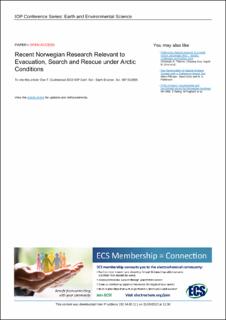| dc.description.abstract | Marine traffic is increasing in the Arctic Region. As ice in the Arctic Region retracts, opportunities for the marine industry increase. This relates to the fishing industry, which is moving further into the Arctic Seas, the shipping industry, which is using the Northern Sea Route, particularly for transporting liquefied natural gas, and the cruise industry, which is transporting passengers to the last frontier on the globe. The question has been raised: Are the marine industry's activities in the Arctic Region safe for people, the environment and assets? The International Maritime Organization's (IMO) Polar Code, which came into force in 2017 sets requirements for ships and procedures, as well as for the competence of those involved. In particular, there have been uncertainties regarding how people on board a ship in distress can be saved should it be necessary to abandon ship. The question is of considerable concern in Norway, which is a main stakeholder in the Arctic Region, with the involvement/passage of many fishing, cargo and cruise vessels. Over several years, considerable research has therefore been carried out to review the status of safe operations in the Arctic Region and to identify methods to improve the safety of all involved in the Arctic maritime traffic. This paper presents a summary of recent Norwegian research relevant to safe evacuation, search and rescue under Arctic conditions. The summary includes the outcome of the Norwegian research programme, Sarinor, the SARex exercises carried out by the University of Stavanger, the Norwegian Coast Guard and the industrial company GMC (Stavanger) in 2016, 2017 and 2018, as well as follow-up research carried out later. Its implementation in the IMO is also discussed. Finally, thoughts on continuing the work to further improve safety are presented. | en_US |

